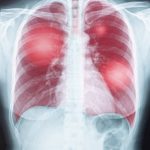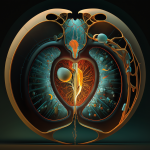The ONE organ responsible for high blood pressure.
Pulmonary Hypertension: Symptoms and Causes

Pulmonary arterial hypertension (PAH) is a devastating, life-threatening disease with a rapid progression and poor prognosis when untreated [1–3].
Pulmonary hypertension cannot be cured, but treatments can reduce your symptoms and help you manage your condition. If the cause is identified and treated early, it may be possible to prevent permanent damage to your pulmonary arteries, which are the blood vessels that supply your lungs.
Symptoms
The signs and symptoms of pulmonary hypertension develop slowly. You may not notice them for months or even years. Symptoms get worse as the disease progresses. Pulmonary hypertension signs and symptoms include:- Blue lips and skin (cyanosis)
- Chest pressure or pain
- Dizziness or fainting spells (syncope)
- Fast pulse or pounding heartbeat (palpitations)
- Fatigue
- Shortness of breath (dyspnea), initially while exercising and eventually while at rest
- Swelling (edema) in the ankles, legs and eventually the belly area (abdomen)
Causes
The typical heart has two upper chambers (atria) and two lower chambers (ventricles). Each time blood passes through the heart, the lower right chamber (right ventricle) pumps blood to the lungs through a large blood vessel (pulmonary artery). In the lungs, the blood releases carbon dioxide and picks up oxygen. The blood typically flows easily through blood vessels in the lungs (pulmonary arteries, capillaries and veins) to the left side of the heart. However, changes in the cells that line the pulmonary arteries can cause the walls of the arteries to become stiff, swollen and thick. These changes may slow down or block blood flow through the lungs, causing pulmonary hypertension. Pulmonary hypertension is classified into five groups, depending on the cause.Group 1: Pulmonary arterial hypertension (PAH)
Causes include:- Unknown cause (idiopathic pulmonary arterial hypertension)
- Changes in a gene passed down through families (heritable pulmonary arterial hypertension)
- Use of certain drugs or illegal substances
- Heart problems present at birth (congenital heart disease)
- Other conditions such as HIV infection, chronic liver disease (cirrhosis) and connective tissue disorders (scleroderma, lupus, others)
Group 2: Pulmonary hypertension caused by left-sided heart disease
Causes include:- Left-sided heart valve disease such as mitral valve or aortic valve disease
- Failure of the lower left heart chamber (left ventricle)
Group 3: Pulmonary hypertension caused by lung disease
Causes include:- Chronic obstructive pulmonary disease (COPD)
- Scarring of the tissue between the lung's air sacs (pulmonary fibrosis)
- Obstructive sleep apnea
- Long-term exposure to high altitudes in people who may be at higher risk of pulmonary hypertension
Group 4: Pulmonary hypertension caused by chronic blood clots
Causes include:- Chronic blood clots in the lungs (pulmonary emboli)
- Other clotting disorders
Group 5: Pulmonary hypertension triggered by other health conditions
Causes include:- Blood disorders, including polycythemia vera and essential thrombocythemia
- Inflammatory disorders such as sarcoidosis and vasculitis
- Metabolic disorders, including glycogen storage disease
- Kidney disease
- Tumors pressing against pulmonary arteries
Eisenmenger syndrome and pulmonary hypertension
Eisenmenger syndrome is a type of congenital heart disease that causes pulmonary hypertension. It's most commonly caused by a large hole in the heart between the two lower heart chambers (ventricles), called a ventricular septal defect. This hole in the heart causes blood to flow incorrectly in the heart. Oxygen-carrying blood (red blood) mixes with oxygen-poor blood (blue blood). The blood then returns to the lungs — instead of going to the rest of the body — increasing the pressure in the pulmonary arteries and causing pulmonary hypertension.Risk factors
Pulmonary hypertension is more often diagnosed in people ages 30 to 60. Growing older can increase the risk of developing Group 1 pulmonary hypertension, called pulmonary arterial hypertension (PAH). However, PAH from an unknown cause (idiopathic PAH) is more common in younger adults. Other things that can raise the risk of pulmonary hypertension include:- A family history of the condition
- Being overweight
- Blood-clotting disorders or a family history of blood clots in the lungs
- Exposure to asbestos
- Congenital heart disease
- Living at a high altitude
- Use of certain drugs, including some weight-loss medicines and illegal drugs such as cocaine or methamphetamine
- Use of selective serotonin reuptake inhibitors (SSRIs), used to treat depression and anxiety
Complications
Potential complications of pulmonary hypertension include:- Right-sided heart enlargement and heart failure (cor pulmonale). In cor pulmonale, the heart's right lower chamber (ventricle) becomes enlarged. It has to pump harder than usual to move blood through narrowed or blocked pulmonary arteries. As a result, the heart walls thicken and the right ventricle expands to increase the amount of blood it can hold. But these changes create more strain on the heart, and eventually the right ventricle fails.
- Blood clots. Having pulmonary hypertension increases the risk of blood clots in the small arteries in the lungs.
- Irregular heartbeats (arrhythmias). Certain arrhythmias caused by pulmonary hypertension can be life-threatening.
- Bleeding in the lungs. Pulmonary hypertension can lead to life-threatening bleeding into the lungs and coughing up blood (hemoptysis).
- Pregnancy complications. Pulmonary hypertension can be life-threatening for a developing baby.









